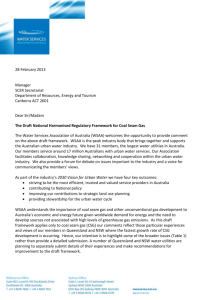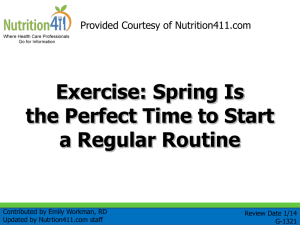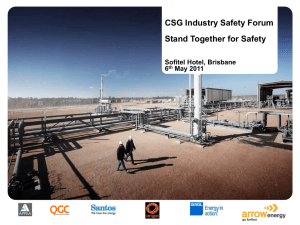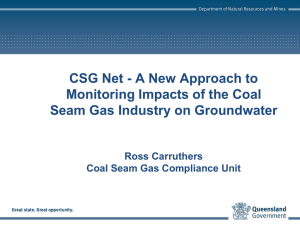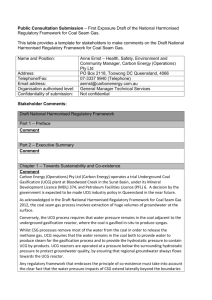G MASTER - CSG Industry Contractor HSE Forum
advertisement
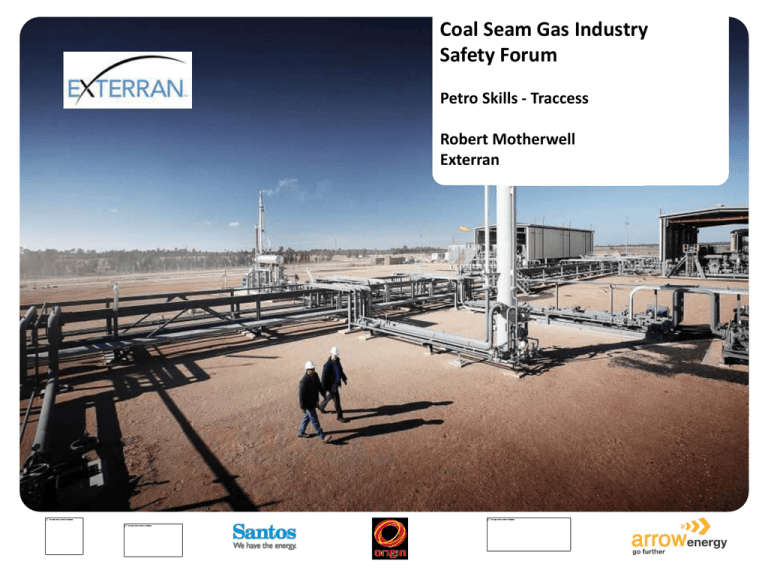
Coal Seam Gas Industry Safety Forum Petro Skills - Traccess Robert Motherwell Exterran The Challenge • Delivering training to all Exterran Employees – Western Hemisphere – Eastern Hemisphere • • • • Australia Providing competent and capable employees when performing work Employees mobility between sites and operators Delivering quality training to all Exterran Employees – QLD, Victoria, Western Australia, Northern Territory • Financial challenge – Travel Costs to train personnel – Large groups for training • Operations – Rostered employees - multiple training sessions required • After Market Services – Employees away from their base location on irregular shifts – Employees on Rosters Overcoming The Challenge.... • Identified most participants in industry face similar challenges • Exterran combined with PetroSkills to map our training requirements • Exterran worked with PetroSkills to provide an E Learning tool that could assist us in delivering and managing quality training (Traccess) • Exterran Australia was selected as the pilot area for Exterran • Training packages needed to be rewritten so they could be self learning • Familiarity of Traccess program The Result.... • • • • • • • Every module is competency assessed Employees can now receive quality training via an E-learning system Training is completed in an office environment or out at site locations Learners only need an internet connection to complete training Exterran can now demonstrate competency and capability Employees now have a self paced training program according to their role Captures external training needs CSG Industry Safety Forum – 6th May 2011 Coal Seam Gas Industry Safety Forum The Journey to Zero Mark Hoogsteyns FK Gardner & Sons The Challenge.... As at Jan 2009 • Poor safety culture – influenced by construction industry culture • High incident rates • Poor incident management • Lack of management focus on safety – leadership void • Significant incident at Santos Fairview – Jan 2009 – – – – – Stopped work – off site for 4 months Poor response to incident Poor understanding of actual safety needs of CSG clients Worked with Santos – 120 safety system improvements (already AS4801) Embarked on Federal Safety Scheme Accreditation – 64 further improvements to the system • Taking our staff on the journey Overcoming The Challenge.... • Leadership Participation – Safety Leadership Team – Consultative – Site visits – task observations – link to KPI’s • Significant change to systems – – – – • Education, education, education – top to bottom Consistency in communication Give them simple tools – SOS books, Online inductions, Online systems access Getting the right people (Safety to Site) Improve injury management – Use APPEA injury classification – across the group • • Measurability - lead and lag indicators, KPI’s Recognise & Reward good behaviour To improve is to change; to be perfect is to change often. Winston Churchill The Result.... • 2yrs 3mths LTI Free • AITFR - Group - 2008: 26.4, 2009: 13.7, 2010: 10.7 2011 0 YTD Civil 2008: 9, 2009: 12.2, 2010: 0 2011 0 YTD • FSC Accreditation March 2011 • Subcontractor safety forums across the state • No Subcontractor bashing – actually help them – better the devil you know – safer, more secure & less litigation • Winner of the: – 2009 & 2010 Master Builders -Innovation in Workplace Health and Safety – 2011 NCSI Chairman’s Award for Management Systems Excellence CSG Industry Safety Forum – 6th May 2011 Coal Seam Gas Industry Safety Forum Leighton Safety Essentials Michael Walsh – GM SHE Leighton Contractors Pty Ltd The Challenge.... Total EPC1 Incidents - 27 The Challenge.... Total PC1 Incidents - 237 Overcoming the Challenge.... Leighton Safety Essentials Permit to Work Working at heights Working in and around mobile plant Working with services Electrical work Mechanical heavy lifting Working in and around live traffic Managing temporary works Overcoming The Challenge.... • Mapping the Potential Class One Incidents • Introduction of “Working above the Line” philosophy • Divisional Task Forces established – Campaign Plans developed • Campaign plans monitored by Executive and Board • Development of Essentials for each critical risk • Development of Active Risk Management of Essential Activities • Roll out of Essentials Critical Risk Training • Ongoing Implementation Audits • Promotion of above the line initiatives Overcoming the Challenge.... Major focus of the Essentials initiative is to move risk controls away from lower order custom and practice into higher order- “harder” controls for critical risks. The Result.... The Result.... CSG Industry Safety Forum – 6th May 2011 Coal Seam Gas Industry Safety Forum Stop Work Authority Jason Sullivan Weatherford The Challenge.... • We work in an Industry where we are constantly under pressure to deliver and hence it is often very difficult for our people to stop a job • Over the years we have seen what the consequences of inaction can lead to when unsafe acts are not stopped • Other parties refusing to acknowledge the associated risks with a particular task and pressure is being exerted on Weatherford personnel to “get the job done” without proper safety controls in place. • Employees recognizing unsafe conditions and acts, but not feeling empowered to stop the operation Overcoming The Challenge.... Aggressive approach not effective: Getting the right people involved to develop a safe solution to rectify unsafe conditions and complete the operation safely: The Result.... • Example of SWA: – A vertical Pipe Racking System (PRS) slid off of it’s Horizontal track coming to rest against a Derrick Beam close to the Monkey board… CSG Industry Safety Forum – 6th May 2011 Coal Seam Gas Industry Safety Forum Positive Operational Safety Targets (POST) Dennis Bagnoche – Group HSE Manager Clough Seam Gas Positive Operational Safety Targets - POST • • • POST is designed to encourage a pro-active approach towards HSE target setting using Lead Indicators. Aligned to AS/NZS 4801 – 4.3.3 Objectives and targets. POST has been around Clough since 2003 firstly beginning in the Offshore Industry POST Headings and example : – – – – – – – – – – Leadership and Commitment – Qty of management site inspections Planning – site design and layout POST target reviews – daily input, weekly and monthly reviews Training, Competency and Awareness – TNA, VOC’s, Inductions. HSE Communication – Item close outs from committee meetings, toolbox meetings frequency and compliance Hazard and Risk Management – HAZIDS, JHA, Plant Risk Assessments Emergency Preparedness and Response – ER exercises conducted Inspection and Measurement – site inspections, light vehicles, lifting equipment Incident and Injury Management – Incident investigations raised within 24hours Audits, Reviews and Improvements – internal, external, subcontractor audits The Challenge… • Embedding the POST system at project inception • Monitoring compliance to set targets and objectives • Setting the right culture to ensure the Project Management Team has ownership and accountability • Ensuring compliance does not waiver and lose momentum • Aligning the system with clients expectations and Joint Venture/Partnership arrangements • Ensuring there is dedicated support and resources provided to input, retrieve and communicate data • Reporting of negative indicators Overcoming the Challenge and the Results Overcoming the Challenge: • Education on safety culture, identifying POST as a tool that enhances safety performance and solid compliance • Engaging the workforce at all levels to ensure buy in from Project personnel • Project managers are not bound explicitly by Corp Targets and Objectives for Lead Indicators, Projects have the flexibility to set own attainable targets based on agreed Project goals with clients • Development of Safety Leadership Team (SLT) with personal objectives and targets aligned to POST • Project manning to include dedicated HSE resources to manage data integrity Results: • Excellent HSE performance represented in graphs and dashboards • A program based on proactive measures with lead indicators rather than reactive frequency rates • Reduction of exposure to legal obligations and enhances Risk Management Principles • Lessons learnt tool, captures what has been done well and what needs improvement • Proactive approach with tangible results that are physically seen • A workplace that looks and feels safe • Dedicated workforce with the right culture committed to zero incident and harm


